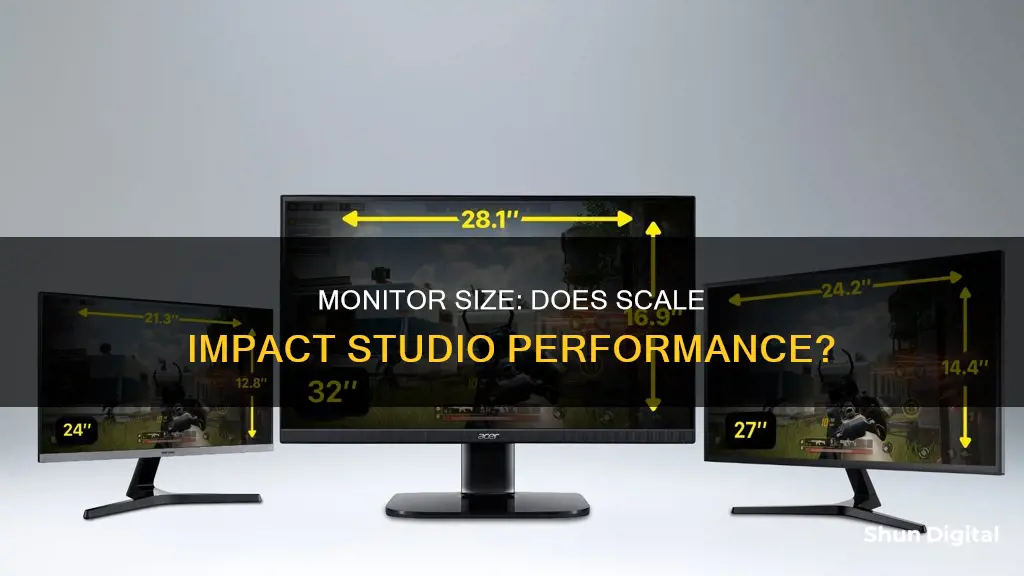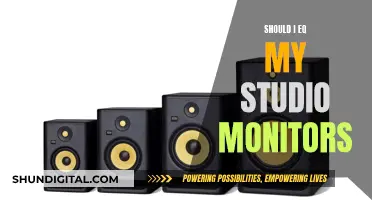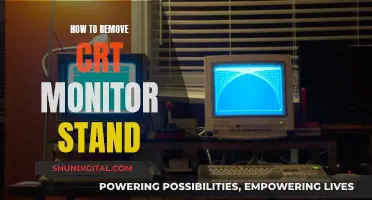
Studio monitor size does matter, but it's not a complicated matter. Studio monitor size should align with studio size. Smaller monitors work best for smaller rooms, while bigger monitors provide better and more accurate translations in more spacious studios. Getting a monitor that's too small or too big for a room won't represent recordings and mixes as accurately as possible.
What You'll Learn

Studio monitor size should align with studio size
Smaller studio monitors are best suited for smaller rooms, while bigger monitors will provide better and more accurate translations in more spacious studios. If you get a monitor that's too small or too big for your room, it won't represent your recordings and mixes as accurately as possible.
The quality of a studio monitor's recordings and mixes is influenced dramatically by the acoustics in the room. Therefore, it's recommended to have some form of control over your room's acoustic element so that the monitor can represent music as accurately and precisely as possible.
If you're setting up a home studio, consider adding a basic acoustic treatment to your equipment. That way, your speakers can unleash sounds that are unaffected or minimally affected by the room's sound refractions.
While it's important to consider room size when selecting a studio monitor, other factors come into play as well. The kind of music you're looking to record, the monitor's sound quality, and the device's precision are all important factors to keep in mind. Additionally, room acoustics, which have nothing to do with the device itself, can also influence the precision and accuracy of your chosen model.
Asus ROG Monitors: Worth the Hype and Price?
You may want to see also

Smaller monitors are better for smaller rooms
When it comes to studio monitors, size does matter, and smaller monitors are indeed better suited for smaller rooms. This is because the size of the studio monitor should ideally align with the size of the studio or room in which it is placed.
In a small room, the limited space can cause issues with sound reflection and reverberation, impacting the overall sound quality. Smaller studio monitors can help mitigate these issues by reducing the amount of sound reflection and creating a more accurate and balanced sound across the entire range of frequencies.
Additionally, smaller studio monitors can provide a more precise listening experience, allowing for a better evaluation of the nitty-gritty details of the mix. This is crucial for ensuring that your recordings and mixes are represented as accurately as possible, regardless of the room's acoustics.
While some people may suggest that larger studio monitors can be used in a small room by simply turning down the volume, this approach may not always yield optimal results. Larger monitors may still struggle to accurately reproduce low-end frequencies in a small room due to the impact of room modes and standing waves.
Furthermore, the position of the studio monitor within the room also plays a crucial role in sound quality. Smaller monitors are typically easier to position and require less distance between the listener and the speaker, making them a more versatile option for smaller spaces.
Overall, when it comes to studio monitors, it is essential to consider the size of the room and choose accordingly. While other factors such as room treatment and speaker placement are also important, selecting the right-sized studio monitor is a crucial step in achieving the best sound quality for your space.
Internet Privacy: Government Surveillance and Online Monitoring
You may want to see also

Bigger monitors are better for bigger rooms
When it comes to studio monitors, size does matter, and bigger monitors are indeed better for bigger rooms. The general rule of thumb is that studio monitor size should align with studio size.
In a larger room, bigger monitors will provide a better and more accurate translation of your recordings and mixes. With smaller monitors, your productions may not be represented as accurately or powerfully as they could be.
Bigger monitors can deliver a fuller, richer sound that fills the room. They can also reduce distortion and ensure a more precise balance across the entire range of frequencies. This is especially important if your productions feature powerful low-end frequencies, as smaller monitors may not be able to reproduce these as effectively.
Of course, room acoustics will always be a factor, and you may need to treat your room acoustically to ensure the best sound quality. But as a general rule, for bigger rooms, bigger monitors are the way to go.
Unlocking ASUS Monitor: Opening OSD Settings
You may want to see also

Monitor size impacts sound quality
Studio monitor size does matter when it comes to sound quality, and it's important to choose the right size for your space. The general rule of thumb is that smaller monitors are better suited for smaller rooms, while bigger monitors provide better and more accurate translations in larger studios. If the monitor is too small or too big for the room, it won't accurately represent recordings and mixes.
The acoustics of the room play a significant role in the resulting sound quality. Even with the same studio monitor, the acoustics of your room will impact the mix. This means that auditioning a set of studio monitors in someone else's studio or a shop may not yield the same results in your own space.
To get the most out of your studio monitors and ensure accurate sound representation, it's recommended to add a basic acoustic treatment to your equipment setup. This will help minimise the impact of room sound refractions on the speakers' performance.
While the size of the studio monitor is important, other factors also come into play. The position of the speaker in the room, as well as the speaker volume, can affect the sound quality. Additionally, the construction materials and application-specific benefits of the studio monitors should be considered.
In summary, when it comes to sound quality, studio monitor size does matter. However, it's crucial to strike a balance between the size of the monitor and the size of the room, taking into account other factors such as speaker placement, volume, and acoustic treatment.
Monitoring IO Usage: Linux Tips and Tricks
You may want to see also

Monitor size impacts the accuracy of recordings and mixes
Studio monitor size does matter when it comes to the accuracy of recordings and mixes. While it is not a complicated matter, selecting the right size can ensure that your recordings and mixes are represented as accurately as possible.
In most cases, studio monitor size should align with studio size. Smaller monitors are typically better suited for smaller rooms, while bigger monitors provide improved and more precise translations in larger spaces. Choosing a studio monitor that is too small or too large for the room can result in less accurate representations of your recordings and mixes.
The position of the speakers in the room also plays a crucial role in achieving accurate sound. It is important to focus on finding the right position for the speakers, regardless of their size.
Additionally, the quality of your studio monitor's recordings and mixes is significantly influenced by the acoustics of the room. To ensure accurate and precise representations, it is recommended to have some form of control over the room's acoustic element. Acoustic treatment can help in minimising the impact of the room's sound refractions on the speakers.
When it comes to low-end frequencies, bigger speakers have an advantage in providing more accurate representations. Smaller speakers may struggle to reproduce these lower frequencies, making it challenging to produce an accurate mix. However, it is worth noting that excessive low-end frequencies in a small room can lead to acoustic issues and standing waves.
In summary, while studio monitor size does impact the accuracy of recordings and mixes, it is also important to consider the room size, speaker position, acoustic treatment, and the desired low-end frequency response when making a decision.
Understanding ELMB Sync on ASUS Monitors
You may want to see also
Frequently asked questions
Yes, studio monitor size does matter. The size of the studio monitor should be aligned with the size of the studio. Smaller monitors work best for smaller rooms, while bigger monitors provide better and more accurate translations in more spacious studios.
Yes, the size of the studio monitor can affect the sound, especially in smaller rooms. Smaller monitors may not be able to produce as much bass as larger monitors, which can make it difficult to accurately mix and master music.
The ideal studio monitor size for a home studio depends on the size of the room. For a typical bedroom studio, a monitor between 4-6 inches is recommended. If the room is on the smaller side, a 5-inch monitor may be the best option.
No, volume should not be a major concern when choosing a studio monitor size. Bigger speakers can be turned down to match the sound pressure of smaller speakers, and they have the advantage of reducing distortion.
Yes, the position of the speaker in the room also plays a significant role in how the room responds to the signal. It is important to ensure that the speakers are placed at the correct distance from the listener and from each other to ensure optimal sound quality.







